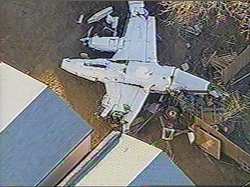 The National Transportation Safety Board has
released the following update of its investigation of the midair
collision between a Piper PA-31T twin-engine Cheyenne (N360LL) and
a single-engine Cessna 172 (N52241) on January 24, 2003, over
northwest Denver, Colorado. Both aircraft were destroyed by impact
forces and fire. Five people were killed in the crash.
The National Transportation Safety Board has
released the following update of its investigation of the midair
collision between a Piper PA-31T twin-engine Cheyenne (N360LL) and
a single-engine Cessna 172 (N52241) on January 24, 2003, over
northwest Denver, Colorado. Both aircraft were destroyed by impact
forces and fire. Five people were killed in the crash.
Airplane Wreckage
The wreckage from both airplanes has been collected and secured
at an aircraft salvage facility in Greeley, Colorado. Today,
the wreckage is being carefully laid out and examined by
investigators from the NTSB with assistance from the Federal
Aviation Administration (FAA), New Piper Aircraft Company, and
Cessna Aircraft Company. The wreckage will be examined in an effort
to document paint transfer marks, scratch marks, and structural
damage, to assist in determining the collision angles between the
two airplanes. This activity will continue over the next 2 days.
Maintenance records for each airplane are also being secured and
will be examined.
Air Traffic Control Issues
 As a routine part of any investigation involving a
midair collision in or near controlled airspace, the NTSB formed an
Air Traffic Control (ATC) group. The group chairman is an ATC
specialist from NTSB Headquarters in Washington, D.C. who arrived
in Denver on Sunday. The ATC group consists of representatives from
the FAA in Washington, D.C., and local representatives
As a routine part of any investigation involving a
midair collision in or near controlled airspace, the NTSB formed an
Air Traffic Control (ATC) group. The group chairman is an ATC
specialist from NTSB Headquarters in Washington, D.C. who arrived
in Denver on Sunday. The ATC group consists of representatives from
the FAA in Washington, D.C., and local representatives
from the National Air Traffic Controllers Association. Yesterday,
the group visited the Denver ATC Approach Control facility in
Denver, Colorado, and received an initial briefing regarding the
facility. The group also viewed the radar playback, listened to
recorded ATC voice communications, and downloaded recorded radar
data for further analysis. The following information has been
obtained thus far from the ATC group:
The pilots were not required, according to FAA regulations, to
contact ATC; however, both pilots requested and received a service
known as visual flight rules (VFR) flight following. As a result,
one controller was providing basic radar services to both pilots
which include safety alerts, traffic advisories and limited radar
vectoring when requested by the pilot. The group will be
interviewing ATC controllers today [Monday], and will continue to
analyze the radar data and voice recordings.
Sequence of Events
 The following sequence of events is according to
preliminary information.
The following sequence of events is according to
preliminary information.
About 5:00 p.m. CST, the Cessna 172 departed from Centennial
Airport enroute to Cheyenne, Wyoming. About 5:10 p.m., the Piper
Cheyenne departed Jefferson County Airport enroute to Centennial
Airport. At 5:17 p.m., the Piper Cheyenne pilot reported to the
Denver Approach controller. When asked, the Piper Cheyenne pilot
reported that his altitude was 7,800 feet.
About 90 seconds later, the Cessna 172 pilot contacted the
controller. The Cessna was at 7,300 feet and requested to climb to
8,500 feet. The request was granted.
About ten seconds later, the controller asked the Piper Cheyenne
pilot his altitude. The Piper Cheyenne pilot indicated that he was
flying at 7,600 feet. The controller then issued a traffic advisory
to the Piper Cheyenne pilot advising that there was a Cessna at the
Piper Cheyenne's twelve o'clock position and 1 mile at 7,700 feet.
The collision occurred shortly
thereafter.
Weather and Lighting Environment
 The reported weather conditions about the time of
the accident allowed for flights to be conducted under VFR. The
reported visibility was about 10-15 miles and the cloud conditions
were reported as broken and scattered from 6,000 feet to 14,000
feet mean sea level. Additionally, the sun had set about 20 minutes
prior to the collision. Safety Board investigators will
The reported weather conditions about the time of
the accident allowed for flights to be conducted under VFR. The
reported visibility was about 10-15 miles and the cloud conditions
were reported as broken and scattered from 6,000 feet to 14,000
feet mean sea level. Additionally, the sun had set about 20 minutes
prior to the collision. Safety Board investigators will
continue to investigate the effects that lighting may have had on
the pilots' ability to see other aircraft.
 SpaceX to Launch Inversion RAY Reentry Vehicle in Fall
SpaceX to Launch Inversion RAY Reentry Vehicle in Fall Aero-News: Quote of the Day (04.23.24)
Aero-News: Quote of the Day (04.23.24) Aero-News: Quote of the Day (04.20.24)
Aero-News: Quote of the Day (04.20.24) ANN's Daily Aero-Linx (04.20.24)
ANN's Daily Aero-Linx (04.20.24) Aero-News: Quote of the Day (04.21.24)
Aero-News: Quote of the Day (04.21.24)






